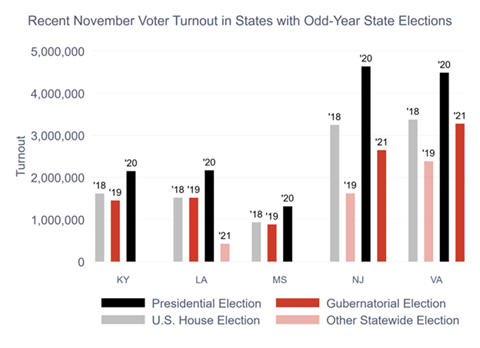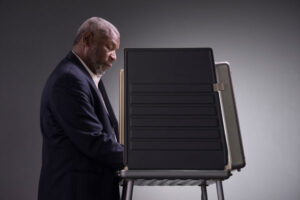Supporters argue that by far the most important reason to increase federal funding for elections is also the simplest: we must be able to trust that our representatives have been determined by the voice of the people. Proponents argue that leaders of both parties are eroding this bedrock of the most successful republic in history by casting doubt on our election results. Both Republican and Democratic supporters argue that given how meager current funding for administering elections is, our system is in danger of failing under the partisan stress we are increasingly placing on the system. They argue that we should invest significantly more to meet this fundamental threat to American self-government.
Supporters further argue that it is appropriate for the federal government to fund its fair share of the cost of addressing the challenge that bitter partisanship poses to trust in the nation’s elections. Proponents make three traditional arguments for the federal role in meeting the funding need.
First, they argue that Congress should play a role in funding elections because the U.S. Constitution mandates that states hold elections for the U.S. House and Senate.
Second, because Congress has imposed mandates on the states for federal elections that impact the cost of state and local elections in the four pieces of legislation discussed above, supporters argue that it should help fund these elections.
The NVRA currently applies to 44 states and Washington, D.C. The Act’s state mandates include allowing mail-in voter registration, providing voter registration opportunities when eligible voters apply for a driver’s license (the origin of the nickname “Motor Voter”), limiting how early states can set cutoff dates for registering, and requiring a uniform and regular voter registration list maintenance program.
These requirements create demands for management and computer systems that many states would not have undertaken absent the NVRA. As cybersecurity issues have risen in importance, these federally mandated voter registration systems have become a major point of vulnerability that states are now responsible for defending.
HAVA required states to replace outdated mechanical lever and punch-card voting machines in federal elections. It also required states to implement a statewide voter registration list.
At the time of HAVA’s passage, nearly half of voters cast ballots on lever and punch-card machines, which in some cases had been in service for a half-century. The HAVA voting equipment mandate had the effect of requiring localities to rely on computerized tabulation equipment that had a more limited useful life than they had previously chosen.
Prior to HAVA’s registration list mandate, localities frequently maintained voter lists, often using paper systems. This requirement also mandated complicated systems of computers, software, and networks that are expensive to design, implement, and protect from cyberattacks.
The third traditional argument supporters make for federal funding is that federal elections draw more voters than state and local elections. More people vote when federal offices are on the ballot than when comparable state races are at the “top of the ticket.” Because one-third of voters are best described as “federal only” voters, many supporters argue that the federal government should provide about $2 billion per year, which is one-third of the $6 billion per year in total election costs.
It is unclear precisely how many voters would cast ballots in even-numbered-year elections if federal offices weren’t on the ballot, but the experience of the five states that conduct statewide elections in odd-numbered years gives us a clue.
Five states conduct statewide elections for governor and state legislatures in odd-numbered Novembers: Kentucky, Louisiana, Mississippi, New Jersey, and Virginia. The figure below shows the turnout levels for each statewide November election from 2018 to 2021, a complete election cycle. The bold black and red bars help to compare voter turnout for presidential races with that for races for governor, respectively. Looking back across the most recent presidential and gubernatorial elections in these five states, average presidential-year turnout has been 50% greater than turnout in gubernatorial years.

Comparing mid-term congressional elections (grey bars) with corresponding state legislative elections (pink bars), we see an even greater disparity between turnout for comparable federal and state elections — turnout in congressional-only elections was on average 130% greater than in state-legislature-only elections.
Federal elections attract many “federal only” voters. When it comes to the chief executives (president and governor), federal-only voters account for one-third of voters in these five states. In purely legislative elections, federal-only voters account for more than half of those who turn out.
These three long-standing arguments for a significant federal role in elections funding have been joined by a growing chorus arguing for federal funding to address the growing need to defend against the threat of cyberattacks from foreign and domestic adversaries. They argue that the national security implications of cyberattacks on our nation’s election infrastructure justify a federal funding solution.
In addition, these national security concerns have prompted a growing amount of support on the right – where the least support for federal funding has traditionally been found.
For example, in December 2021, several right leaning groups, including Americans for Tax Reform, R Street Institute, and FreedomWorks, sent Congressional leadership a letter calling for “robust and consistent assistance to state and local governments to ensure the integrity of our nation’s election infrastructure.” The letter’s signers noted that election administrators needed the assistance of the federal government “to go toe-to-toe with the offensive cyber-capabilities of foreign militaries.”
Among federal funding supporters, there remains disagreement on the terms and amount of such funding. Perhaps the most fundamental question among supporters is whether the next round of federal funding should be another one-time allocation or if there should be a move to an ongoing commitment, for example, like federal government highway funding.
Most proponents of federal funding argue for an ongoing commitment for two reasons. First, they argue it gets us beyond being merely reactive to a problem after it has already occurred. They argue that some of the past crises could have been avoided if election infrastructure were better maintained. One of these crises, in 2000, brought the country to the brink of a constitutional crisis.
Second, as experience with the 2002 HAVA appropriations has shown, when Congress provides large infusions of cash on the heels of a crisis that was caused by under-investment in election infrastructure, the reaction of state and local officials is one of two strategies, neither of which produces optimal outcomes. The first is to make hasty purchasing decisions. The second, ironically enough, is exactly the opposite: to hoard funds on a belief that things could get even worse. Both strategies reflect the cash-starved nature of election administration and the infrequency of being able to make major purchasing decisions based on a strategic vision.
The ongoing approach gains more Republican support when fewer strings are attached to the funding. Conservatives emphasize that state and local officials are in the best position to know where the money is best spent. Those on the right also argue that funding with fewer federal requirements more appropriately adheres to the constitutional mandate that states conduct elections. Some Democrats argue that establishing more specific requirements better ensures that the money is spent where it is intended to be spent.
A recent bipartisan proposal from several national organizations staked out a middle ground. Its supporters argued that additional funding should be tied to a limited set of minimum standards in critical areas such as voter registration, counting, and security. Still, virtually all supporters of additional federal elections support agree that some assistance, even if it is one-time funding, is better than no assistance.
The next most important question debated among those who support additional federal funding is how much should be provided. Last year, for example, the Election Infrastructure Initiative asked Congress to consider $20 billion over ten years ($2 billion per year). More recently, President Biden included $10 billion over ten years ($1 billion per year) in his most recent budget proposal. Others have suggested federal funding of around $5 billion over ten years ($500 million per year).




